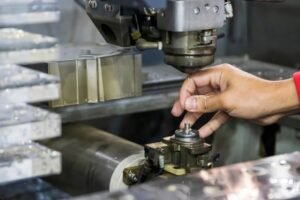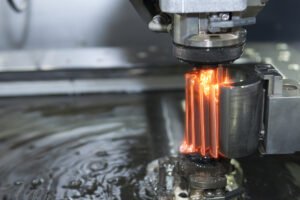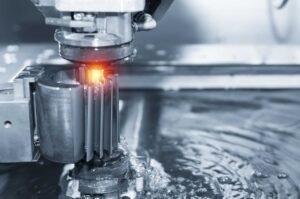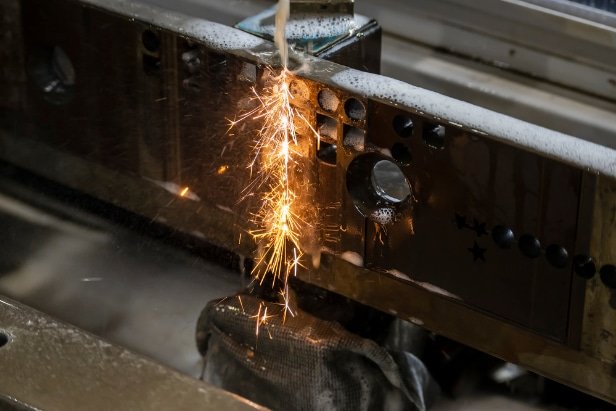Electrical Discharge Machining (EDM) stands out as a critical process for shaping intricate components with exceptional accuracy. However, the effectiveness and longevity of EDM machines heavily rely on the maintenance of their essential components.
Understanding the intricate mechanisms behind EDM machining and the proper maintenance protocols is paramount for ensuring consistent performance and prolonging the lifespan of these sophisticated systems.
In this guide, we delve into the components of EDM machining and explore comprehensive strategies for their upkeep, providing invaluable insights into optimizing operational efficiency and minimizing downtime.
Components of EDM Machining
Components of EDM Machining
The process of electrical discharge machining (EDM) relies on several crucial components: the workpiece, the tool electrode, dielectric fluid, and a power source.
Each element plays a distinct role in facilitating the EDM process, collectively contributing to its efficiency and precision. Let’s delve deeper into the function and significance of these components to gain a comprehensive understanding of how EDM operates.
Workpiece
At the heart of any machining endeavor lies the workpiece, the material undergoing shaping or forming. In EDM, the workpiece requirement is relatively simple—it must possess electrical conductivity properties.
Unlike traditional machining methods where the workpiece’s machinability dictates the feasibility of the process, EDM can effortlessly tackle even the toughest of metals. Secured firmly in place by a jig or fixture, the workpiece serves as the canvas upon which the EDM process unfolds.
Tool Electrode
The tool electrode, often simply referred to as the electrode, serves as the catalyst for the EDM process, generating sparks when brought into close proximity with the workpiece. Crafted from materials like graphite, copper, tungsten, or their alloys, the choice of electrode material depends on the specific EDM technique employed.
Whether it’s wire EDM utilizing a thin wire electrode or fast hole EDM employing a tubular electrode, precise control is maintained through servo motors, ensuring a consistent spark gap between the electrode and the workpiece as dictated by CNC pathways.
Dielectric Fluid
A fundamental aspect of EDM machining is the presence of dielectric fluid, typically housed within a tank surrounding the workpiece and electrode. Acting as a coolant and debris remover, dielectric fluid—whether it’s deionized water or a non-conductive lubricating oil—prevents molten particles from adhering to the electrode by carrying them away.
Additionally, the fluid aids in controlling the electrical discharge between the electrode and the workpiece, contributing to the overall stability and efficiency of the process.
Power Supply
Driving the entire EDM operation is the power supply, responsible for regulating the release of electrical charges that fuel the machining process. Tailoring the frequency and strength of the electrical current to suit the specific requirements of the job at hand, the power supply orchestrates the series of charges that traverse the electrode, culminating in precise sparks at the points of closest proximity between the electrode and the workpiece.
Notably energy-intensive, EDM harnesses the power supply to execute thousands of sparks concurrently, steadily eroding the workpiece to achieve the desired shape and dimensions.

How to Maintain Components of EDM Machining
Maintaining components of EDM machining is essential for ensuring consistent performance, prolonging equipment lifespan, and minimizing downtime. Here’s a detailed description of how to maintain each component:
1. Workpiece Maintenance:
- Regular Inspection: Inspect workpieces for signs of wear, damage, or irregularities before and after machining.
- Cleanliness: Keep workpieces free from contaminants, debris, or residual dielectric fluid that may affect machining accuracy.
- Surface Protection: Apply appropriate coatings or treatments to protect workpiece surfaces from corrosion or oxidation during storage.
2. Tool Electrode Maintenance:
- Electrode Inspection: Check electrodes for wear, chipping, or deformation after each machining cycle.
- Electrode Cleaning: Remove debris, residue, or built-up material from electrode surfaces using appropriate cleaning methods or solvents.
- Electrode Replacement: Replace worn or damaged electrodes promptly to maintain machining precision and avoid damage to workpieces.
>>> Read more: What is EDM Machining? Types of EDM Machines
3. Dielectric Fluid Maintenance:
- Fluid Quality Monitoring: Regularly monitor dielectric fluid condition, including clarity, pH levels, conductivity, and contamination levels.
- Filtration: Use filtration systems to remove impurities, particles, or contaminants from dielectric fluid to maintain its effectiveness.
- Fluid Replacement: Replace dielectric fluid at recommended intervals to prevent buildup of contaminants and ensure consistent machining performance.
4. Power Supply Maintenance:
- Voltage Calibration: Periodically calibrate power supply voltage settings to ensure accurate control of electrical discharge during machining.
- Electrical Safety Checks: Conduct routine inspections of power supply components for signs of wear, damage, or malfunction.
- Backup Power Systems: Implement backup power systems or surge protectors to safeguard power supply equipment from electrical fluctuations or outages.

Applications of Electrical Discharge Machining (EDM)
Understanding the optimal scenarios for utilizing electrical discharge machining (EDM) is crucial in maximizing its efficacy and efficiency within manufacturing processes. While conventional machining methods suffice for certain tasks, EDM excels where traditional approaches prove inadequate, particularly in achieving intricate shapes and tight tolerances.
EDM proves most beneficial in scenarios where:
- Fine Cuts and Narrow Deep Holes: Parts requiring precise cuts, narrow deep holes, or intricate geometries benefit from EDM’s ability to navigate complex contours with exceptional accuracy.
- Complex Shapes with Tight Tolerances: Components with intricate designs and stringent tolerances find EDM advantageous due to its capability to achieve precise shapes without physical contact, minimizing the risk of distortion or damage.
- Machining Challenging Materials: EDM’s proficiency extends to processing hard, electrically conductive materials that pose challenges for conventional machining methods, enabling the production of intricate parts with superior precision.
Across various industries, EDM finds widespread application:
- Manufacturing: In the production of dies and molds, EDM facilitates the creation of intricate features and details essential for manufacturing processes.
- Aerospace: EDM is instrumental in crafting precision holes in turbine components, ensuring optimal performance and reliability in aerospace applications.
- Medical: The medical industry relies on EDM for manufacturing devices with fine features and intricate details, meeting the stringent requirements of medical equipment and implants.
Moreover, EDM’s versatility extends to low-volume production needs, including:
- Toolmaking: EDM is indispensable in toolmaking, where precision and intricacy are paramount for producing molds, dies, and tooling components.
- Prototyping: For rapid prototyping and iterative design processes, EDM offers the flexibility to create prototypes with intricate geometries and precise features.
- Small-Series Production: EDM’s precision and efficiency make it ideal for small-series production runs, where maintaining consistency and quality across limited quantities is essential.
In the realm of injection molding, EDM complements traditional machining techniques:
Injection Molding Tool Production: Combining EDM with traditional machining methods enables the creation of high-quality molds with fine features and details, optimizing the balance between speed and precision. This dual approach results in shorter lead times and reduced costs compared to relying solely on EDM for mold production.

Conclusion
Above, MaTec Vietnam helped you understanding the components of Electrical Discharge Machining (EDM) and implementing effective maintenance practices are paramount for ensuring the continued reliability and performance of EDM systems. By comprehensively addressing the maintenance needs of each component – from the workpiece and tool electrode to the dielectric fluid and power supply – manufacturers can prolong equipment lifespan, minimize downtime, and optimize machining quality.
Regular inspection, cleaning, and calibration of components, coupled with adherence to manufacturer-recommended maintenance schedules, are essential steps in preserving the integrity and efficiency of EDM systems. Moreover, investing in operator training and documentation of maintenance activities facilitates proactive troubleshooting and decision-making, further enhancing operational reliability.

